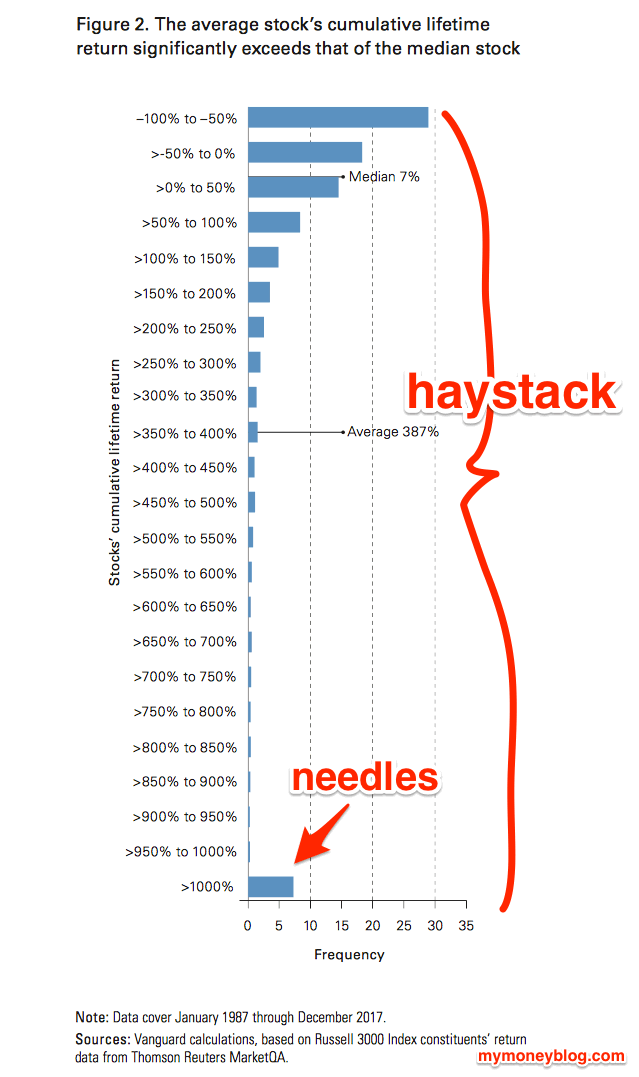Vanguard has a new research paper on How to increase the odds of owning the few stocks that drive returns [pdf], found via How Concentration Affects Portfolio Performance by Michael Batnick. Inside, there is a chart that sorts the individual returns of the US stock market (Rusell 3000) over the last 30 years (1987-2017) into total performance buckets. What happens to the stock prices of individual companies over 30 years? Lots of big losers. A few huge winners.

The whitepaper has a lot of math and investment jargon that you can read for yourself. Let’s skip to the conclusion here:
Historical cumulative returns of individual stocks are skewed whereby overall market returns are determined by a small minority of stocks. Therefore, all else being equal, a more diversified portfolio is more likely to hold these outperforming stocks while displaying a lower dispersion of portfolio returns. We conducted simulations of various portfolio sizes and showed that those portfolios with fewer holdings underperformed those with more holdings, leading to a higher return hurdle to overcome.
As the late Jack Bogle told us: “Don’t look for the needle in the haystack. Just buy the haystack.”
I don’t know which will be the most successful US companies in the future, but I know that I will own them via the total US index fund in my portfolio. I will own the next Amazon, Google, Facebook, Apple, or Visa. I’ll also own whoever disrupts them after that. Since I own a big chunk of global stocks inside the Vanguard Total International Stock Index fund, I’ll be covered if they come from the other side of the world.
Now, when you own the entire haystack, you will get the losers as well as the winners. Also, I won’t be as rich as if I invested in them when operated out of a dorm room. It just turns out that in this capitalist structure, owning them all still works out pretty darn well. I will own shares of all these businesses in proportion to their market value, and by extension a share of their profits. Some of those profits will be reinvested for future growth, and some will be sent to me as cash dividends every three months. I’ll happily spend those dividends, and the let rest grow into more dividends in the future.
 The Best Credit Card Bonus Offers – 2025
The Best Credit Card Bonus Offers – 2025 Big List of Free Stocks from Brokerage Apps
Big List of Free Stocks from Brokerage Apps Best Interest Rates on Cash - 2025
Best Interest Rates on Cash - 2025 Free Credit Scores x 3 + Free Credit Monitoring
Free Credit Scores x 3 + Free Credit Monitoring Best No Fee 0% APR Balance Transfer Offers
Best No Fee 0% APR Balance Transfer Offers Little-Known Cellular Data Plans That Can Save Big Money
Little-Known Cellular Data Plans That Can Save Big Money How To Haggle Your Cable or Direct TV Bill
How To Haggle Your Cable or Direct TV Bill Big List of Free Consumer Data Reports (Credit, Rent, Work)
Big List of Free Consumer Data Reports (Credit, Rent, Work)
Great article, it gives one of the best most succinct arguments for the benefits of large index funds. I’ll be sharing it.
Trying to find a needle in the haystack means you have to get lucky three times — one to find the needle, two to buy the needle, and three to sell the needle at the right time. I wholeheartedly agree there’s no need take these huge risks when you can just buy the whole haystack.
https://www.makingyourwealth.com/save-home-runs-for-baseball/